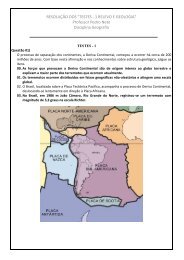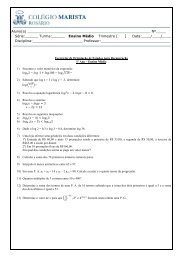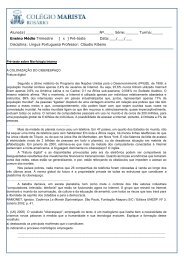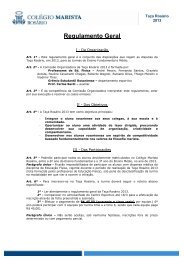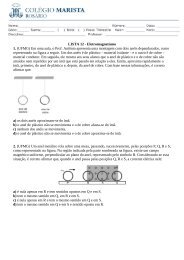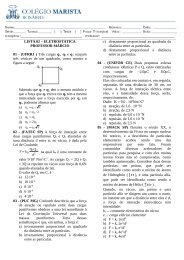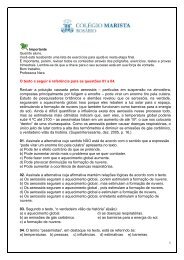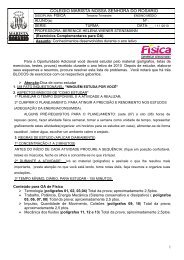NÚMEROS COMPLEXOS 1) Calculando-se corretamente as raízes ...
NÚMEROS COMPLEXOS 1) Calculando-se corretamente as raízes ...
NÚMEROS COMPLEXOS 1) Calculando-se corretamente as raízes ...
Create successful ePaper yourself
Turn your PDF publications into a flip-book with our unique Google optimized e-Paper software.
27. O polinômio do 3º grau cujo gráfico está repre<strong>se</strong>ntado na figura a <strong>se</strong>guir é:<br />
a) 3<br />
x – 3<br />
b) 3<br />
c) 1<br />
2 x3 – 6x 2 + 15<br />
4 x3 – 15<br />
2<br />
4 x2 + 6x – 3<br />
2 x3 – 5<br />
2 x2 + 4x – 3<br />
d) x 3 – 4x 2 + 5x – 2<br />
e) x 3 – 5x 2 + 8x – 4<br />
28. O valor de m que torna iguais <strong>as</strong> <strong>raízes</strong> da equação 3x 2 + 2x + m = 0 é:<br />
a) 1<br />
3<br />
b) 1<br />
2<br />
c) 2<br />
d) 3<br />
e) não existe<br />
29. Os reais 1, a e b são soluções distint<strong>as</strong> de x 3 – 6x 2 + 11x – 6 = 0. O valor de a + b é:<br />
a) – 6<br />
b) – 5<br />
c) 5<br />
d) 6<br />
e) 11<br />
30. Considere o gráfico abaixo.<br />
Es<strong>se</strong> gráfico pode repre<strong>se</strong>ntar a função definida por:<br />
a) f(x) = x 3 + 5x 2 – 20x<br />
b) f(x) = x 3 + 5x 2 – 4x – 20<br />
c) f(x) = x 4 + 5x 3 – 20x – 4<br />
d) f(x) = x 4 + 5x 3 – 4x – 20<br />
e) f(x) = x 4 + 5x 3 – 4x 2 – 20x<br />
31. Considerando <strong>as</strong> <strong>raízes</strong> do polinômio p(x) = x 4 + 16, pode-<strong>se</strong> afirmar que p(x):<br />
a) não tem <strong>raízes</strong> no conjunto dos números complexos<br />
b) tem uma raiz de multiplicidade 4<br />
c) tem quatro <strong>raízes</strong> complex<strong>as</strong> distint<strong>as</strong><br />
d) teem du<strong>as</strong> <strong>raízes</strong> dupl<strong>as</strong><br />
e) tem por gráfico uma curva que troca de concavidade



